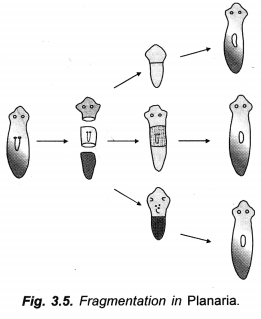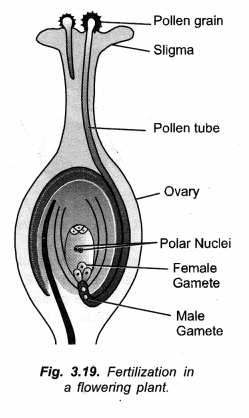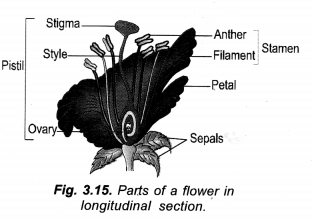NCERT Exemplar Solutions for Class 10 Science Chapter 8 How do Organisms Reproduce?
These Solutions are part of NCERT Exemplar Solutions for Class 10 Science. Here we have given NCERT Exemplar Solutions for Class 10 Science Chapter 8 How do Organisms Reproduce?
NCERT Exemplar Solutions for Class 10 Science Chapter 8 Short Answer Questions
Question 1.
In a bisexual flower, inspite of the young stamens being removed artificially, the flower produces fruit. Provide a suitable explanation for the above situation.
Answer:
The open flowers are generally cross pollinated. Removal of stamens of a bisexual flower will not affect pollination of its intact pistil and formation of fruit.
More Resources
- NCERT Exemplar Solutions for Class 10 Science
- NCERT Solutions for Class 10 Science
- Value Based Questions in Science for Class 10
- HOTS Questions for Class 10 Science
- Previous Year Question Papers for CBSE Class 10 Science
Question 2.
Can you consider cell division as a type of reproduction in unicellular organisms ? Give one reason.
Answer:
Yes. Cell division in a unicellular organism which produces two d&ughter cells, actually forms two daughter individuals.
Question 3.
What is a clone ? Why do offspring formed by asexual reproduction exhibit remarkable similarity ?
Answer:
Clone is an exact genetic replica of another individual. All the offspring formed from a parent through asexual reproduction are clones of one another as well as their parent. The remarkable similarity of asexually produced daughter individuals is due to genetic similarity as they possess exact copies of DNA of their parent.
Question 4.
Explain how, offspring and parents of organisms reproducing sexually have the same number of chromosomes/DNAs.
(CCE 2014, CBSE Delhi 2017)
Answer:
The parents are diploid (2n) as each of them has two sets of chromosomes (DNAs). They form haploid (In) male and female gametes through the process of meiosis. The haploid gametes have one set of chromosomes (DNAs). During fertilization, one male gamete fuses with one female gamete. It restores the diploid (2n) chromosome/DNA number in the offspring that is formed from fusion product or zygote (2n).
Question 5.
Colonies of yeast fail to multiply in water but multiply in sugar solution. Give one reason for this.
Answer:
Yeast is heterotrophic. It obtains its nourishment from outside. Plain water cannot provide nourishment to yeast while sugar solution can do so. Therefore, Yeast multiplies in sugar solution and not in plain water.
Question 6.
Why does Bread Mould grow profusely on a moist slice of bread rather than on a dry slice of bread ?
Answer:
Growth of Bread Mould requires both water and nutrients. Dry slice of bread contains nutrients but no water. Therefore, Bread Mould does not grow over it. Moist slice possesses both water and nutrients. Hence, Bread Mould grows over it.
Question 7.
Give two reasons for the appearance of variations among the progeny formed by sexual reproduction.
Answer:
Variations appear in the progeny of sexually reproducing organisms due to
- Random separation and coming together of chromosomes during gamete formation and gamete fusion
- Crossing over and mutations.
- Coming together of chromosomes of the parents.
Question 8.
Would a Planaria cut vertically into two halves regenerate into two individuals ?
Answer:
Yes. Each piece of Planaria is able to grow the missing parts and form the complete organism.
Question 9.
Correlate the number of chromosomes with the size of the organism and answer the following questions :
(a) Do larger organisms have more number of chromosomes/cell ?
(b) Can organism with fewer chromosomes reproduce more easily than organism with more number of chromosomes ?
(c) More the number of chromosomes/cell, greater is the DNA content. Justify.
Answer:
(a) No. There is no correlation between chromosome number and size of the individual.
(b) No. Chromosome number does not affect reproduction.
(c) Yes. Each chromosome represents a single duplex of DNA. More chromosomes means more DNA.
Question 10.
In Tobacco, male gametes have 24 chromosomes.
(a) What is the number of chromosomes in the female gamete ?
(b) What is the number of chromosomes in the zygote ?
Answer:
(a) 24
(b) 48.
Question 11.
Why cannot fertilization take place in flowers if pollination does not occur ?
Answer:
Pollination is essential for bringing the male gametes. In the absence of pollination, there will be no male gamete to perform fertilization.
Question 12.
Is the chromosome number of zygote, emboryonal cells and adult of a particular organism always constant ? How is the constancy maintained in these three stages ?
Answer:
Zygote is the first diploid structure. It undergoes mitotic divisions to form embryonal cells. Embryonal cells further divide by mitosis to form the adult. Mitosis maintains the same chromosome number in the daughter cells.
Question 13.
Where is the zygote located in the flower after fertilization ?
Answer:
Zygote is the fertilized oosphere which occurs in the embryo sac present inside an ovule located in the ovary part of the pistil.
Question 14.
Reproduction is linked to stability of population of a species. Justify the statement.
Answer:
Reproduction maintains the size and composition of population of a species by regularly adding new individuals for replacing the ones getting killed due to ageing, disease or predation. It also adds variations that allow the individuals to adapt to changing environment.
Question 15.
How are general growth and sexual maturation different from each other ?
Answer:
General growth is the growth of an individual in size, height, shape, weight, etc. Sexual maturation is a set of changes in body of an individual that enable one to take part in reproduction, e.g., maturation of gonads, genitalia and other accessory structures. In human beings, beginning of sexual maturation is indicated by puberty changes like cracking of voice, new hair pattern, development of breast in female, etc.
Question 16.
Trace the path of sperm during ejaculation and mention the glands and their function associated with the male reproductive system.
Answer:
Ejaculated sperms are the ones which are stored in epididymes. They are formed regularly in seminiferous tubules from where they pass through vasa efferentia into epididymes. At the time of ejaculation, the sperms are first pushed through vasa deferentia, enter ejaculatory duct where they receive secretion of seminal vesicles and then urinogenital duct where the secretion of prostate gland is poured to form semen. The urinogenital duct is lubricated by secretion of a pair of Cowper’s glands (bulbourethral glands).
Secretion of Seminal Vesicles. Nourishment, activation and providing fluid medium for sperm transport.
Secretion of Prostates Gland. Motility of Sperms.
Question 17.
What changes are observed in the uterus if fertilization does not occur ? (CBSE Delhi 2017)
Answer:
Glands present in the mucosa of uterine endometrium begin to degenerate. This sloughs off the endometrial lining, releasing a lot of mucus and blood. It is called menstruation. Menstruation lasts for 3-5 days.
Question 18.
What changes are observed in the uterus subsequent to implantation of young embryo ? (CBSE Delhi 2017)
Answer:
Endometrium thickens, becomes glandular and highly vascular. The contact region between embryo and uterine wall grows into placenta. Placenta helps the embryo in obtaining nourishment and oxygen from blood sinuses of the uterus. It also helps in transfer of wastes from embryo to the blood of the mother.
Question 19.
What are the benefits of using mechanical barriers during sexual act ?
Answer:
- Prevention of Pregnancy : Mechanical barriers (e.g., Condoms, diaphragms) prevent the passage of sperms into the genital tract of the female. Consequently, pregnancy does not occur.
- Non-transmission of Infections: There is no transfer of venereal diseases from the infected partner to the non-infected partner.
Question 20.
In the female reproductive system, name the parts that are involved in
(a) Production of egg.
(b) Site of fertilization
(c) Site of implantation
(d) Entry of sperms.
Answer:
(a) Production of Egg: Ovary
(b) Site of Fertilization: Ampulla part of fallopian tube.
(c) Site of Implantation: Uterus.
(d) Entry of Sperms: Vagina.
Question 21.
What would be the ratio of chromosome number between an egg and its zygote ? How is the sperm genetically different from the egg ?
Answer:
Chromosome Number in Egg and Zygote. 1 : 2
Genetic Difference between Sperm and Egg. Sperms are genetically of two types, X-containing and Y-containing. Eggs are always of one type, X-containing.
NCERT Exemplar Solutions for Class 10 Science Chapter 8 Long Answer Questions
Question 22.
Why are budding, fragmentation and regeneration all considered as asexual types of reproduction ? With neat diagrams, explain the process of regeneration in Planaria.
Answer:
(a) Asexual Reproduction: Budding, fragmentation and regeneration are all considered to be modes of asexual reproduction as they involve formation of new individuals from single parents without fertilization or fusion of gametes.
(b) Regeneration in Planaria:

Question 23.
Write two points of differences between asexual and sexual types of reproduction. Describe why variations are observed in the offspring formed by sexual reproduction.
Answer:
(a) Differences between Asexual and Sexual Reproduction
| Asexual Reproduction | Sexual Reproduction |
| 1. Parents: It is monoparental. | It is generally biparental |
| 2. Meiosis: Meiosis does not occur during asexual reproduction. There are no gametes and no fertilization. | Meiosis occurs. Gametes are formed and fertilization occurs in sexual reproduction. |
| Ex. Binary fission in Amoeba, Budding in Yeast | Ex. Offspring in Wheat, Human. |
(b) Development of Variation in Sexual Reproduction:
Sexual reproduction produces a number of variations in the population due to
- Chance separation of chromosomes at the time of meiosis.
- Crossing over during meiosis.
- Chance combination of chromosomes during fertilization. It produces a unique combination of variations already accumulated by each individual in its DNA obtained from its parents,
- Mutations or defective DNA replication.
Question 24.
Distinguish between pollination and fertilization. Mention the site and product of fertilization in a flower. Draw a neat, labelled diagram of a pistil showing pollen tube growth and its entry into the ovule.
Answer:
(a) Differences between Pollination and Fertilization
| Pollination | Fertilization |
| 1. Definition: It is transfer of pollen grains from anther to the stigma of a flower.
2. Step: Pollination precedes fertilization. 3. Purpose: It carries the male gamete producing pollen grains to the female sex organ. 4. Process: Pollination is a physical process. 5. Occurrence: It occurs only in seed plants. |
It is the fusion of male and female gametes.
Fertilization occurs only after pollination when the pollen grain has germinated and male gametes are carried into ovule. It actually brings about fusion of gametes. Fertilization is a physico-chemical (biological) process. It occurs in both plants and animals of various types. |
(b)
- Site of Fertilization. Embryo sac in ovule.
- Product of Fertilization. Zygote, Primary endosperm cell.
(c)

Question 25.
Distinguish between a gamete and zygote. Explain their roles in sexual reproduction.
Answer:
Differences between Gamete and Zygote
| Gamete | Zygote |
| 1. Nature: It is sex or germ cell that takes part in fertilization. | It is a product of fertilization. |
| 2. Types: There are two types of gametes, male and female. | Zygote is of one type. |
| 3. Chromosome Number: A gamete has haploid or In chromosome number. | Zygote has diploid or 2n chromosome number. |
| 4. Characteristics: A gamete carries characteristics of only one parent. | It carries characteristics of both the parents. |
| 5. Generation: Gamete is the last cell of its generation. | It is the first cell of new generation. |
Role of Gamete. Gamete is sex or germ cell which is specialized to take part in sexual reproduction. There are two types of gametes, male and female. Each of them carries one set of chromosomes which are randomly obtained from its parent. Fusion of male gamete with a female gamete produces a zygote.
Role of Zygote. It is the first’cell of new generation. Zygote develops into embryo that later forms the new individual.
Question 26.
Draw the diagram of a flower and label the four whorls. Write the names of gamete producing organs in the flower.
Answer:
(a)

(b) Male Gamete Forming Part. Pollen grain, produced in anther of stamen.
Female Gamete Forming Part. Embryo sac developed inside ovule of ovary part of pistil.
Question 27.
What is placenta ? Mention its role during pregnancy. (CCE 2011, 2014)
Answer:
Placenta: It is a special double layered, spongy tissue connection between the foetus and uternine wall found in pregnant females. It has finger-like outgrowths or villi which are in contact with blood sinuses present in the uterine wall.
Role:
- Attachment: Placenta attaches the foetus to uterine wall.
- Villi: Placenta has finger-like outgrowths or villi which develop a large surface area for fixation and absorption.
- Nutrients: Placenta picks up nutrients from mother’s blood and passes it to the blood of the foetus.
- Waste Products: Waste products produced by the foetus passes out through the placenta into mother’s blood.
- Gases: Foetus obtains oxygen supply from mother’s blood and eliminates carbon dioxide through placenta.
Question 28.
What are the various ways to avoid pregnancy ? Elaborate any one method.
Answer:
(a) Methods to Avoid Pregnancy: Prevention of pregnancy is called contraception. The techniques used in preventing the occurrence of pregnancy are called contraceptive devices.
(b) Mechanical Barrier Methods of Contraception:
- Mechanical Barriers like condoms, cervical cap, diaphragm.
- Oral Contraceptives or oral pills like Mala D, Saheli
- Intrauterine Contraceptive Devices (IUCD) like loop, bow, Cu-T.
- Surgical Methods like vasectomy in males and tubectomy in females.
Question 29.
Flow does fertilization take place ? Fertilization occurs once in a month. Comment.
Answer:
In human beings, fertilization is internal. It can occur within 2-3 days of ovulation (between 14th and 16th day of menstrual cycle). Fertilization generally takes place in ampulla (ampulla-isthmus border) part of fallopian tube where ovum rests for several hours after entry into oviduct. The sperms have to reach there. Sperms deposited in the vagina reach there partly by their own movement and partly by local movements of reproductive tract. Both sperms and eggs are viable for 24-48 hours. A sperm reaching the surface of ovum, dissolves its covering and passes its head and middle part into it. It results in fertilization and formation of zygote.
Fertilization only once in a Month. A single ovum is released by female roughly in the middle of menstrual cycle which has a span of 4 weeks. Therefore, fertilization can occur only once in a month.
Question 30.
Reproduction is essentially a phenomenon that is not for survival of individual but for the stability of a species. Justify. Reproduction is not essential for survival of the individual.
Answer:
Survival of the individual depends upon input of nutrients and energy and elimination of wastes. Reproduction has ho role in these. It is, however, essential for the stability and survival of the species. Reproduction takes part in
(a) Perpetuation of Species: Perpetuation or continuation of species.
(b) Replacement: Replacement of dead individuals and maintaining the organisation in population.
(c) Population Characteristics:
- Education: There is an inverse ratio between education and population growth.
- Population Education: It is imparting knowledge to public about the effects of excessive population, advantages of small families and means to achieve it.
- Marriageable Age: Number of births is reduced if young persons marry late. Gainful employment and higher social status of women also reduce birth rate.
(d) Variations:
Variations are differences found in morphological, physiological and other traits of individuals belonging to the same organism, race or family. They develop due to
- Faulty DNA replication
- Crossing over
- Chance separation of chromosomes during meiosis and chance combination during fertilization. Variations are highly important.
(e) Absence of Variations: Due to absence of variations, asexually reproduced organisms are unable to adapt themselves to changes in the environment.
Question 31.
Describe sexually transmitted diseases and mention the ways to prevent them.
Answer:
It is a group of infections caused by different types of pathogens that are transmitted by sexual contact between a healthy person and an infected person. The sexually transmitted diseases are also called venereal diseases (VDs). Some 30 different types of STDs are known.
- It is caused by bacterium Neisseria gonorrhoeae. Gonorrhoea spreads through sexual contact, common toilets and under clothes. Incubation period is 2-5 days. Bacterium resides in genital tubes. It causes pus containing discharge, pain around genitalia and burning sensation during urination. Effective medicine is ampicillin.
- The disease is caused by corkscrew like bacterium Treponema pallidum. It spreads through sexual contact and from mother to infants. Incubation periods is 3-5 weeks, Painless ulcer on genitalia and swelling of lymph glands occur in first stage. In second stage skin lesions, rashes and hair loss occur. Tertiary stage is characterised by chronic ulcers and damage to vital organs. Effective medicine is tetracycline.
- Genital Warts: The disease is due to Human Papilloma virus (HPV). Hard benign outgrowths called warts appear over external genitalia and perianal area. In women infection may enter vagina and cervix causing acute pain. Cryosurgery and Podophyllum preparations are effective.
- AIDS (Acquired Immune Deficiency Syndrome): It is caused by human immunodeficiency virus or HIV. The virus is transmitted through sexual contact, blood contact (as using common needles, syringes, razors, transfusion) and placenta (mother to foetus). Incubation period is generally 27-28 months but symptoms may appear early. Count of T-helper cells becomes low, 200/ml or less. There is headache, rashes, nausea, pharyngitis and fever. Immunity is drastically reduced so that many infections (opportunistic infections) begin to appear. A proper treatment has not yet been discovered. ART (antiretrovirus treatment) is given to patients to reduce the effect of infection.
Hope given NCERT Exemplar Solutions for Class 10 Science Chapter 8 How do Organisms Reproduce? are helpful to complete your science homework.
If you have any doubts, please comment below. Learn Insta try to provide online science tutoring for you.